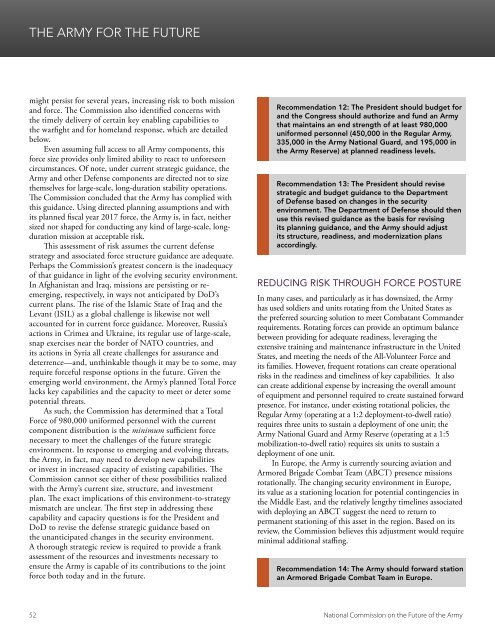THE FUTURE OF THE ARMY
Futurearmy
Futurearmy
You also want an ePaper? Increase the reach of your titles
YUMPU automatically turns print PDFs into web optimized ePapers that Google loves.
<strong>THE</strong> <strong>ARMY</strong> FOR <strong>THE</strong> <strong>FUTURE</strong><br />
might persist for several years, increasing risk to both mission<br />
and force. The Commission also identified concerns with<br />
the timely delivery of certain key enabling capabilities to<br />
the warfight and for homeland response, which are detailed<br />
below.<br />
Even assuming full access to all Army components, this<br />
force size provides only limited ability to react to unforeseen<br />
circumstances. Of note, under current strategic guidance, the<br />
Army and other Defense components are directed not to size<br />
themselves for large-scale, long-duration stability operations.<br />
The Commission concluded that the Army has complied with<br />
this guidance. Using directed planning assumptions and with<br />
its planned fiscal year 2017 force, the Army is, in fact, neither<br />
sized nor shaped for conducting any kind of large-scale, longduration<br />
mission at acceptable risk.<br />
This assessment of risk assumes the current defense<br />
strategy and associated force structure guidance are adequate.<br />
Perhaps the Commission’s greatest concern is the inadequacy<br />
of that guidance in light of the evolving security environment.<br />
In Afghanistan and Iraq, missions are persisting or reemerging,<br />
respectively, in ways not anticipated by DoD’s<br />
current plans. The rise of the Islamic State of Iraq and the<br />
Levant (ISIL) as a global challenge is likewise not well<br />
accounted for in current force guidance. Moreover, Russia’s<br />
actions in Crimea and Ukraine, its regular use of large-scale,<br />
snap exercises near the border of NATO countries, and<br />
its actions in Syria all create challenges for assurance and<br />
deterrence—and, unthinkable though it may be to some, may<br />
require forceful response options in the future. Given the<br />
emerging world environment, the Army’s planned Total Force<br />
lacks key capabilities and the capacity to meet or deter some<br />
potential threats.<br />
As such, the Commission has determined that a Total<br />
Force of 980,000 uniformed personnel with the current<br />
component distribution is the minimum sufficient force<br />
necessary to meet the challenges of the future strategic<br />
environment. In response to emerging and evolving threats,<br />
the Army, in fact, may need to develop new capabilities<br />
or invest in increased capacity of existing capabilities. The<br />
Commission cannot see either of these possibilities realized<br />
with the Army’s current size, structure, and investment<br />
plan. The exact implications of this environment-to-strategy<br />
mismatch are unclear. The first step in addressing these<br />
capability and capacity questions is for the President and<br />
DoD to revise the defense strategic guidance based on<br />
the unanticipated changes in the security environment.<br />
A thorough strategic review is required to provide a frank<br />
assessment of the resources and investments necessary to<br />
ensure the Army is capable of its contributions to the joint<br />
force both today and in the future.<br />
Recommendation 12: The President should budget for<br />
and the Congress should authorize and fund an Army<br />
that maintains an end strength of at least 980,000<br />
uniformed personnel (450,000 in the Regular Army,<br />
335,000 in the Army National Guard, and 195,000 in<br />
the Army Reserve) at planned readiness levels.<br />
Recommendation 13: The President should revise<br />
strategic and budget guidance to the Department<br />
of Defense based on changes in the security<br />
environment. The Department of Defense should then<br />
use this revised guidance as the basis for revising<br />
its planning guidance, and the Army should adjust<br />
its structure, readiness, and modernization plans<br />
accordingly.<br />
REDUCING RISK THROUGH FORCE POSTURE<br />
In many cases, and particularly as it has downsized, the Army<br />
has used soldiers and units rotating from the United States as<br />
the preferred sourcing solution to meet Combatant Commander<br />
requirements. Rotating forces can provide an optimum balance<br />
between providing for adequate readiness, leveraging the<br />
extensive training and maintenance infrastructure in the United<br />
States, and meeting the needs of the All-Volunteer Force and<br />
its families. However, frequent rotations can create operational<br />
risks in the readiness and timeliness of key capabilities. It also<br />
can create additional expense by increasing the overall amount<br />
of equipment and personnel required to create sustained forward<br />
presence. For instance, under existing rotational policies, the<br />
Regular Army (operating at a 1:2 deployment-to-dwell ratio)<br />
requires three units to sustain a deployment of one unit; the<br />
Army National Guard and Army Reserve (operating at a 1:5<br />
mobilization-to-dwell ratio) requires six units to sustain a<br />
deployment of one unit.<br />
In Europe, the Army is currently sourcing aviation and<br />
Armored Brigade Combat Team (ABCT) presence missions<br />
rotationally. The changing security environment in Europe,<br />
its value as a stationing location for potential contingencies in<br />
the Middle East, and the relatively lengthy timelines associated<br />
with deploying an ABCT suggest the need to return to<br />
permanent stationing of this asset in the region. Based on its<br />
review, the Commission believes this adjustment would require<br />
minimal additional staffing.<br />
Recommendation 14: The Army should forward station<br />
an Armored Brigade Combat Team in Europe.<br />
52 National Commission on the Future of the Army


